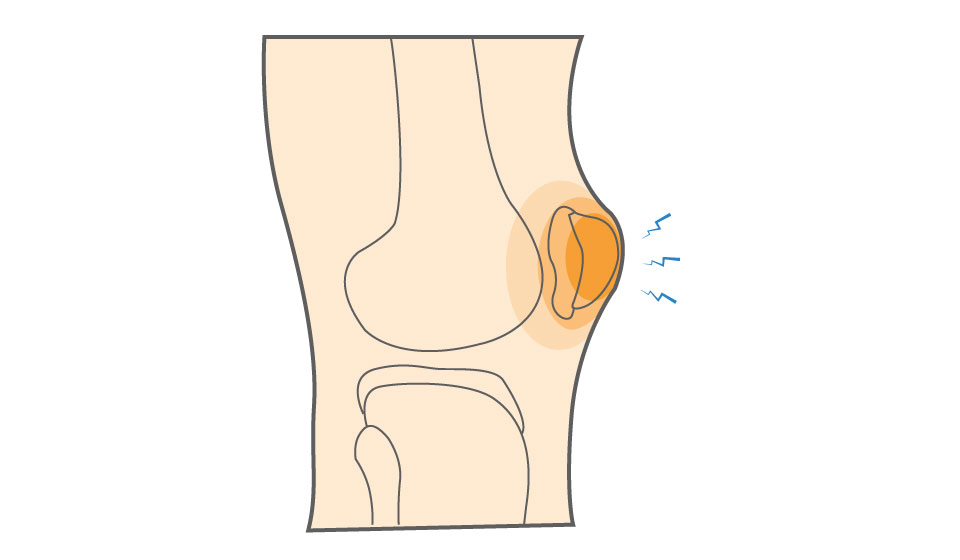Located around the knee are small, jelly-like sacs called bursae. Bursae reduce friction between the bones and soft tissue. Prepatellar bursitis is when the bursae become swollen, causing pain and discomfort with touching or kneeling on the knee.
Prepatellar Bursitis Causes, Symptoms & Treatment Options
Located around the knee are small, jelly-like sacs called bursae. Bursae reduce friction between the bones and soft tissue. Prepatellar bursitis is when the bursae become swollen, causing pain and discomfort when touching or kneeling on the knee.
Overview
Overview

What causes Prepatellar Bursitis?
You are at greater risk for this condition if you play sports such as football, basketball, or wrestling, where falling or suffering a blow directly to the knee is common. This kind of knee injury can damage the bursae. Minor but repeated damage to the kneecap due to constant kneeling or repeated bending of the knees can also cause prepatellar bursitis. People who work on their knees, like plumbers or carpet layers, are prone to this condition.
Sports associated with Prepatellar Bursitis include:
- Rugby
- Wrestling
- Football
- Volleyball
Symptoms
If you have knee bursitis, you may experience pain, swelling, and redness on top of the knee. People with prepatellar bursitis usually can run and jump but experience kneecap swelling. The top of the knee may feel tender and warm to the touch and be painful if you put pressure on it.
When to see a doctor
If you have symptoms of prepatellar bursitis, you should begin with conservative treatment such as:
- Rest: It is important to take the pressure off the front of the knee to allow the bursae to heal. Athletes, particularly those who play high impact sports, should discontinue activities that aggravate their knee. To stay active, lower impact sports such as cycling or swimming could be substituted until symptoms resolve.
- Ice: Applying ice or a cold compress to your knee three or four times a day for 20 minutes can help reduce swelling and alleviate symptoms.
- Medication: Over-the-counter (OTC) medications, like Aspirin or another nonsteroidal anti-inflammatory drug (NSAID) like ibuprofen or Naproxen, can help reduce bursa inflammation and pain.
Non-operative treatment
If your symptoms persist, you should see your doctor. He/She will want to inspect your knee, comparing it to your healthy knee and checking for swelling and range of motion. People with bursitis usually retain a full range of motion and do not experience severe pain, and swelling typically occurs only on the top of the knee.
Usually, knee bursitis can be diagnosed with a patient interview and physical examination. Diagnostic tests, such as an x-ray or other imaging tests, are typically not needed. However, your doctor may order a test to rule out a fracture or other injury. If your knee is warm or there is drainage from the bursae, there may be an infection in the bursae. In that case, your doctor may take some fluid out of the sac and have it analyzed to make sure there is no infection.
Try these exercises to help address your condition:
Below is a PDF of the Exercise Program
Surgical Treatment
When conservative treatments such as rest, ice, and nonsteroidal anti-inflammatory drugs (NSAIDs) do not work, your doctor may remove the fluid from the bursae with a needle. This is called an aspiration. In many cases, this results in relief of the condition. However, occasionally the fluid returns and the procedure needs to be repeated.
Very rarely, surgical treatment of prepatellar bursitis is needed. This is only necessary if conservative treatment did not resolve the problem. The operation involves making a small incision over the swollen bursa and removing it.
Recovery
Recovery time after prepatellar bursitis is hard to predict. With non-operative treatment, recovery is measured in days to weeks. If surgery is needed, then full recovery may take up to three months.
Athletes should consider wearing a knee pad as they resume high impact sports to help prevent recurring cases of bursitis.
GET BACK TO WHAT YOU LOVE. FASTER
Sources
https://orthoinfo.aaos.org/en/diseases–conditions/prepatellar-kneecap-bursitis/
https://www.moveforwardpt.com/SymptomsConditionsDetail.aspx?cid=bee7064c-b0ab-4b49-bffd-68cf989c9dea
https://www.healthline.com/symptom/bursitis
https://www.arthritis-health.com/types/bursitis/prepatellar-bursitis-diagnosis
https://www.summitmedicalgroup.com/library/adult_health/sma_knee_bursitis/
Frequently Asked Questions
Is prepatellar bursitis treatable without surgery?
Absolutely. Most people recover fully with rest, ice, medication, and simple lifestyle adjustments—no surgery needed.
How soon can I expect to feel better?
With early care, many feel relief within a few days to a few weeks
Will wearing a knee pad help?
Yes—it’s a simple and effective way to reduce pressure, especially for athletes or anyone working on their knees.
Can I prevent it from coming back?
Definitely, being mindful of knee pressure, using protective padding, and treating it right away can go a long way to preventing flare-ups.

